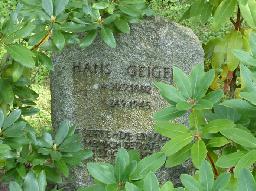Geiger, Hans |
| PHYSICIST (GERMANY) |
|
BORN 30 Sep 1882, Neustadt an der Weinstraße, Rheinland-Pfalz - DIED 24 Sep 1945, Potsdam, Brandenburg BIRTH NAME Geiger, Johannes Wilhelm GRAVE LOCATION Potsdam, Brandenburg: Neuer Friedhof, Heinrich-Mann-Allee 25 |
|
Hans Geiger was the son of the Indologist Wilhelm Ludwig Geiger who was a professor at the University of Erlangen. He studied physics and mathematics in Erlangen and was promoted in 1906. In Manchester he became assistant to Arthur Schuster. After Schuster retired in 1907 he worked for Ernest Rutherford and Ernest Marsdon. Their Geiger-Marsden experiment succeeded in counting alpha particles and supported Rutherford in winning the Nobel Prize in 1908. In 1911 Geiger and John Mitchell Nuttall formulated the Geiger-Nuttall law. In 1912 he was appointed head of radiation research at the National Institute of Science and Technology in Berlin. There he worked with Walther Bothe and James Chadwick, both future Nobel Prize winners. From 1914 to 1918 he served in the German army as an artillery officer. In 1924 he accepted a position at the University of Kiel and with Walther Müller he created a better version of his Geiger tube, the Geiger-Müller tube. This device was able to detect alpha, beta and gamma particles. It was the basis for the famous Geiger counter. In 1929 he became professor of physics in Tübingen and in 1936 he switched to the Technical University of Berlin. In 1939 he participated in the Uranium Club that investigated nuclear weapons. It was concluded that nuclear weapons would play no important part in the war in 1942. Geiger continued his research activities until his death in 1945. Related persons • was teacher of Paul, Wolfgang |
Sources • Kulturbox Berlin, 1996 • FPK Ingenieurgesellschaft mbH • Hans Geiger - Wikipedia (EN) |



